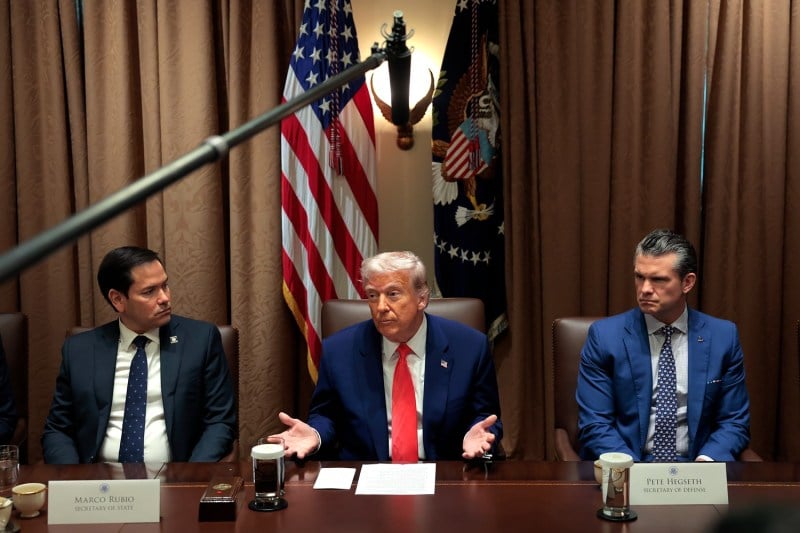How to Strike Trade Deals in Record Time

How to Strike Trade Deals in Record Time
A former U.S. trade negotiator describes how countries should navigate the Trump White House.
U.S. President Donald Trump delivers remarks alongside Secretary of State Marco Rubio (left) and Defense Secretary Pete Hegseth during a cabinet meeting at the White House in Washington on April 10. Anna Moneymaker/Getty Images
U.S. trading partners must have breathed a sigh of relief last week when President Donald Trump announced a 90-day pause on the imposition of tariff rates above 10 percent. However, along with Trump’s economic team, they are quickly realizing that the three-month reprieve, while welcome, is an incredibly short time to hammer out trade deals. Typically, U.S. officials spend at least six months—twice the length of time of the current pause—just to develop their negotiating positions in consultation with Congress and stakeholders. Actual negotiations usually span several years. But as we are learning, these are not normal times.
Countries around the world are scrambling to pull together the best teams and develop strategies, tactics, and substantive offers for a trade negotiation with the United States. The very first thing these countries need to consider is whether they want to push to be at the front of the negotiating queue, a potentially attractive option if they conclude that going early may lead to softer deals. Some may decide that they are better off hanging back and watching how others fare first. This would allow them the opportunity to at least gain a better sense of which negotiating topics (or sweeteners) are of the most importance to the White House and potentially to learn from others’ missteps in this new speed-negotiating world.
U.S. trading partners must have breathed a sigh of relief last week when President Donald Trump announced a 90-day pause on the imposition of tariff rates above 10 percent. However, along with Trump’s economic team, they are quickly realizing that the three-month reprieve, while welcome, is an incredibly short time to hammer out trade deals. Typically, U.S. officials spend at least six months—twice the length of time of the current pause—just to develop their negotiating positions in consultation with Congress and stakeholders. Actual negotiations usually span several years. But as we are learning, these are not normal times.
Countries around the world are scrambling to pull together the best teams and develop strategies, tactics, and substantive offers for a trade negotiation with the United States. The very first thing these countries need to consider is whether they want to push to be at the front of the negotiating queue, a potentially attractive option if they conclude that going early may lead to softer deals. Some may decide that they are better off hanging back and watching how others fare first. This would allow them the opportunity to at least gain a better sense of which negotiating topics (or sweeteners) are of the most importance to the White House and potentially to learn from others’ missteps in this new speed-negotiating world.
Thus far, the Trump administration has referenced a long list of requests of foreign counterparts, including tariff cuts, reductions in trade deficits, increased purchases of U.S. goods, cooperation on countering the China challenge, and much else. Trading partners rightly are now looking for clarity on which of these issues are must-haves, allowing them to focus their efforts on what matters most to the White House during this short window.
Countries are also unclear on whether these negotiations can lead to tariffs below the 10 percent universal rate now in place or whether that rate represents a floor. In addressing this question, Trump indicated last week that there may be some narrow flexibility—but not much. With the recent announcements of special exclusions for phones and other electronic products from the tariff hikes, countries must be more confident now asking for further product exclusions to help their domestic companies weather the tariff storm.
In my recent conversations, foreign trade negotiators have expressed exasperation about making major announcements of U.S. investments or purchases without receiving any credit for these actions in the tariff rates assigned to their countries. To avoid this trap, many are likely to now ascribe to a traditional trade negotiating mantra: Nothing is agreed until everything is agreed.
Foreign counterparts are also likely to initiate their own negotiating requests to the United States, beyond the elimination of the Trump-assigned tariff rates. While most reluctantly accept that these deals will largely be tilted in favor of the United States, they nevertheless will be under domestic pressure to secure gains in the talks. At a minimum, the Trump team should expect countries to request that they be shielded from any future tariff increases. They will negotiate hard to avoid a situation whereby they conclude a deal with the United States in the next 90 days that features formidable concessions and commercial announcements on their part, only to be hit by sectoral or other tariffs over the next three years. If the administration is invested in these agreements, it should take seriously such requests.
The Trump White House also faces several challenges in the next three months. The short negotiating window, coupled with the 70 or so countries seeking agreements, will place tremendous pressure on the U.S. negotiating team. And if Washington and Beijing somehow find a way back to the negotiating table during this period, resources will be even further stretched. Many subcabinet officials await confirmation and some career staff are being let go or leaving on their own volition, resulting in fewer experienced negotiators at a time when they are urgently needed. While led by the Office of the U.S. Trade Representative, as well as the Treasury and Commerce departments, trade negotiations typically involve input from a range of departments including Agriculture, Labor, Health and Human Services, Transportation, and others, many of which are being subjected to massive downsizing by Trump’s Department of Government Efficiency. To deal with these challenges and heighten the chances of success, prioritization with respect to both partners and negotiating topics will be key.
Treasury Secretary Scott Bessent has already identified Japan as a priority partner, with South Korea, Vietnam, and India also cited. We are already seeing a parade of officials from these countries visit Washington. But others are looking for indications of when a slot might open for them. Grouping countries into high-, medium-, and low-priority categories could be a useful internal exercise. Such categorization could be based on a range of factors, including the size of a country’s economy, the magnitude of their trading relationship with the United States, tariff levels, the size of their bilateral trade deficit, the scope of their nontariff measures, and their willingness to join U.S. efforts to counter China.
With respect to substantive matters, prioritization is also key. I have been repeatedly asked whether the administration is seeking more of a commercial deal, focusing on further announcements of new investments and purchases of U.S. energy, agriculture, and weapons, or whether it is more interested in a rules-based agreement with enforcement provisions. It’s not clear whether even U.S. negotiators know the answer to this question, beyond the response of “both.” More clarity is urgently needed if deals are to be struck during the pause period.
Given that each country has its own unique trade regimes and irritants, the Trump administration will need to tailor negotiating requests. If time were not of the essence, this would make perfect sense. But we have only 90 days. What may be useful to consider is what I would call a “tailored template approach.” Specifically, there would be common provisions for all, with details shaped to fit the unique circumstances of the country. For example, on nontariff measures—the barriers that keep U.S. products shut out of a market despite lower tariffs—parties could agree on general rules to govern their reduction over a specified period of time and agree to reinstate tariffs should these commitments not be held. These provisions could then be followed by the list of the specific nontariff measures for each country that would be subject to these commitments.
In entering into talks, the administration will quickly see that it has a serious trust deficit with partners, many of which feel that they have been mistreated and disrespected with Trump’s high tariffs. In such an environment, it’s important for the United States to avoid a situation where countries negotiate detailed deals with cabinet officers only to learn that the president rejects the pact and wants more. Close channels of communication between the White House and the U.S. negotiating team, with clear mandates for officials, will be necessary to steer clear of such situations.
The White House should also give thought now on how to treat partners at the end of the 90 days. A handful may actually reach deals or deals “in principle” with the United States resulting in the lifting of the tariffs. But for countries engaged in good-faith negotiations that are unable to finalize a deal in time, an extension may be warranted. Likewise, more time should be considered for those partners that have requested negotiations with the administration only to be told that they need to wait their turn.
While 90 days may seem like an eternity in the Trump era, it is a highly compressed timeframe in the trade world. U.S. trading partners will not be the only ones feeling the heat. In light of stock market fluctuations, rising prices, a weakening dollar, and the uncertain bond market, the Trump administration will be under pressure to score early negotiating victories to show that its disruptive trade policy is working.
This post is part of FP’s ongoing coverage of the Trump administration. Follow along here.
Wendy Cutler is the vice president at the Asia Society Policy Institute. She previously spent nearly three decades as a diplomat and negotiator in the Office of the U.S. Trade Representative. X: @wendyscutler
More from Foreign Policy
-

U.S. President Donald Trump gives a thumbs-up upon arrival at Joint Base Andrews in Maryland after spending the weekend at Mar-a-Lago. How to Ruin a Country
A step-by-step guide to Donald Trump’s destruction of U.S. foreign policy.
-

Chinese President Xi Jinping arrives for a meeting with Vietnamese National Assembly Chairman Tran Thanh Man in Hanoi on April 14. Why Beijing Is Standing Up to Trump
Chinese leaders have their pride, too.
-

Russian soldiers practice marching Why Don’t Russian Soldiers Revolt?
Astonishing death rates and brutal abuse have not kept troops from following orders.
-

An illustration shows a police officer trying to sudue a panicked mob of men. The Awful History of Tariffs and Depressions
What the 19th century teaches us about what happens next.










Join the Conversation
Commenting on this and other recent articles is just one benefit of a Foreign Policy subscription.
Already a subscriber?
.
Subscribe
Subscribe
View Comments
Join the Conversation
Join the conversation on this and other recent Foreign Policy articles when you subscribe now.
Subscribe
Subscribe
Not your account?
View Comments
Join the Conversation
Please follow our comment guidelines, stay on topic, and be civil, courteous, and respectful of others’ beliefs.
Change your username |
Log out
Change your username:
CANCEL
Confirm your username to get started.
The default username below has been generated using the first name and last initial on your FP subscriber account. Usernames may be updated at any time and must not contain inappropriate or offensive language.